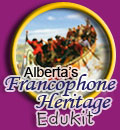 Heritage Community Foundation Presents
Heritage Community Foundation PresentsAlberta Online Encyclopedia
 |
|||||
 |
Home>> Culture and Lifeways>>
Economics>> Industry |
 |
|||
| Industry | |||||
French-Canadians participated in all aspects of industry in Alberta after their arrival at the beginning of the 20th century. Skilled tradesmen were in demand, especially ironworkers and carpenters. The construction of the High Level Bridge in Edmonton, for instance, attracted blacksmiths who had worked on the Quebec Bridge, but were thrown out of work when it collapsed into the St. Lawrence in 1907. The patriarch of the Franco-Albertan Mailloux family (who eventually established a foundry which exists to this day in St. Paul) was among those who came to Alberta to work on the bridge. Lumbering was also a very popular enterprise for French-Canadians, as many of those who were from Eastern Canada had experience in the field. Many operated small sawmills, obtaining permits to exploit forested areas on Crown land across the province. French-Canadians who went to British Columbia looking for seasonal work always found employment easily as it was common knowledge that they were capable workers and knew their way around the dangers of the circular saw. The provincial government condemned hundreds of small lumber mills, many of which still belonged to Franco-Albertans, when it sold off forest rights to large multinational operations in the 1970s. On an individual basis, a man could also prepare dormers for the many railways which were under construction. Trees simply needed to be cut down, the timbers squared, and cut to the proper length. There was always work on railroad crews and many a homesteader left his wife alone with the children and the livestock while he went to earn much needed cash away from home. Working with a threshing crew was another way of earning a living before combining became common in the 1970s. Some entrepreneurs purchased threshing machines and went from farm to farm with their crews. Others had huge steam driven tractors that they used to break farmland, especially in the Peace River area. Coal mining was another option for making some money. There were many mines in southern Alberta, and numerous homesteaders went to work underground until their farms could produce. French-Canadians also invested in the oil industry. Most notable was Dr. Louis Beauchemin of Calgary, long-time president of the Association canadienne-française de l’Alberta (ACFA), who established Sun Oil of Calgary. After 1949, young French-Canadians found work in the oilfield as derrick hands. Many went overseas to work, and because of their common origins, stuck together and formed long lasting friendships. Their bilingualism served many of them well, as their employers needed francophones to work in French Equatorial Africa, Algeria and Morocco, and the young men fit the bill. Franco-Albertans have also been involved in manufacturing. Many potential settlers were skilled tailors and set up shop in various localities. In Edmonton, the La Flèche Brothers tailoring enterprise are a fine example and are still in business today. |
|||||
|
Copyright © 2004 Heritage Community Foundation All Rights Reserved |
|||||
 |
|||||
For more on Francophone Alberta, visit Peel’s Prairie Provinces.
